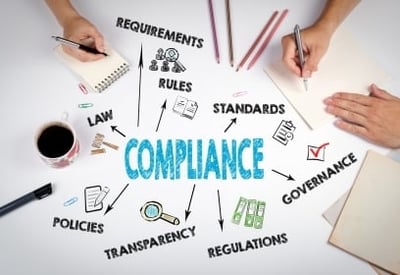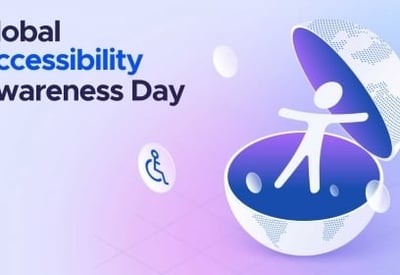Grounded in legislation, shaped by employee expectations and fast becoming a competitive differentiator, workplace accessibility remains a business imperative in 2025.
Whether your organisation operates in the UK, the US or both, understanding the evolving accessibility standards is crucial to staying compliant and creating an environment where every employee can thrive.
In this blog, we break down the key regulations shaping workplace accessibility in 2025 across the UK and US. We cover what’s changing, what’s expected and why embedding accessibility into your workplace culture isn’t just the right thing to do, it’s also smart business.
Why workplace accessibility matters now more than ever
Beyond compliance, workplace accessibility reflects how organisations value their people. It’s about enabling independence, confidence and equal opportunity for everyone.
But here’s the shift. Accessibility is now being recognised as a strategic advantage and businesses that lead in this space are:
- Attracting top talent from a broader, more diverse pool
- Enhancing employee retention and engagement
- Reducing legal risk and boosting brand reputation
- Meeting global ESG and DE&I goals
Governments are taking note, too, strengthening accessibility requirements and pushing for greater accountability.
UK workplace accessibility standards in 2025
1. Equality Act 2010
As the core accessibility legislation in the UK, the Equality Act protects individuals from discrimination in the workplace and requires employers to make “reasonable adjustments” for employees with disabilities.
Even though this legislation was last updated 15 years ago, it’s still as critical for businesses and employers today as it was back then.
What it means in practice:
- Adjustments to physical spaces (e.g. step-free access, accessible toilets)
- Adaptations to working arrangements (e.g. flexible hours or assistive tech)
- Inclusive recruitment and onboarding processes
Reasonable adjustments must be proactive, not reactive. In other words, employers shouldn’t wait for an employee to raise a concern.
2. European Accessibility Act (EAA): *Still relevant for UK businesses
Although the UK is no longer part of the EU, the European Accessibility Act (EAA), which takes effect in June 2025, still matters for UK-based organisations offering products or services within the EU, so aligning with EAA standards is a strategic and reputational must.
Our more in-depth guide breaks the regulation down in more detail, but as an overview, companies in the UK must:
- Comply with EAA standards, regardless of their location, if they trade in the EU.
- Ensure the digital services they provide, including electronic communications, e-books and e-commerce platforms, meet accessibility requirements, often aligning with WCAG 2.1 standards.
- Ensure the physical infrastructure of buildings where EAA-covered digital services are provided, such as bank branches and retail stores, meet the appropriate standards for universal access.
3. Workplace accessibility and the CSRD
Another critical regulation making waves in 2025 is the Corporate Sustainability Reporting Directive (CSRD). While it's an EU directive, which came into effect in January 2024 for large companies and will extend to smaller companies next year, its European operations impact many UK-based multinationals.
The CSRD requires businesses to disclose how they treat social and employee matters, including disability inclusion and workplace accessibility.
You can learn more about the CSRD and its effect on the disability community in this dedicated article.
For UK companies, this means that:
- Accessibility performance will be part of sustainability reporting.
- Transparency around inclusive hiring, retention and workplace design is essential.
- Accessibility becomes a boardroom conversation.
4. Emerging trends in UK accessibility
While no new UK-specific accessibility legislation has been announced for 2025, there’s growing momentum behind:
- Hybrid workplace accessibility and ensuring remote working tools are inclusive.
- in workplace design and communication.
- Digital accessibility audits of intranets, platforms and employee portals.
The best approach? Don’t just do the minimum. Go beyond compliance and use standards like the EAA and CSRD as frameworks for leadership in accessibility.
US workplace accessibility standards in 2025
In the United States, there are a number of well-established federal protections that are relevant to workplace accessibility. While these foundational laws remain in place, their practical application and the broader emphasis on digital inclusion and proactive compliance can be influenced by the evolving political landscape.
1. Americans with Disabilities Act (ADA)
The cornerstone of accessibility in the US is the ADA, particularly Title I, which covers employment.
ADA compliance includes:
- Making reasonable accommodations for employees with disabilities.
- Ensuring workplace spaces are physically accessible.
- Avoiding discriminatory hiring practices.
- Modifying policies and procedures where needed.
2. The Rehabilitation Act of 1973
This long-standing regulation has actually had some recent updates that are important to be aware of today.
For example, the HHS Office for Civil Rights (OCR) finalised updates to Section 504 regulations in May 2024. These clarify and strengthen civil rights protections, address discrimination in medical treatment, add enforceable standards for accessible medical diagnostic equipment and ensure accessible web content and mobile apps.
This is a significant update as it's the first change to Section 504 in 50 years. While there was a lawsuit in late 2024 by several states challenging these updates, the states have recently dropped their constitutional claim against Section 504 itself, though they continue to challenge the updated regulations.
Elsewhere, the most significant update was the "Section 508 Refresh" which came into effect in 2017, to align with WCAG 2.0 AA criteria around digital content accessibility.
Many private sector companies, especially in tech and healthcare, are adopting WCAG (Web Content Accessibility Guidelines) standards voluntarily to reduce legal risk and improve usability.
What this looks like in practice:
- Alt text on images and accessible PDFs.
- Captioned videos and screen-reader compatibility.
- Keyboard navigation support.
In 2025, failing to prioritise digital accessibility is more than a UX issue; it’s a liability.
3. The business case for compliance in the US
Litigation related to digital accessibility continues to rise in the US, with thousands of lawsuits filed annually.
That’s why many leading organisations are reframing compliance as an opportunity by:
- Investing in accessible technologies from day one.
- Running proactive accessibility assessments.
- Embedding inclusive design into physical and digital environments.
That shift mirrors what’s happening globally as accessibility becomes a core part of ESG and DE&I strategies.
Bridging the gap: For businesses operating in both the UK and US
If your organisation spans both regions, aligning with global accessibility standards is more important than ever. While terminology and regulations differ, the direction is clear:
- Legal protections are strengthening.
- Digital accessibility is rising in priority.
- Reporting and transparency are expanding.
Here’s how to get ahead:
- Conduct a Workplace Accessibility Assessment using a tool like Mobility Mojo to benchmark your spaces and systems.
- Ensure procurement policies consider accessibility from the outset.
- Align internal policies with both ADA and Equality Act principles.
- Use the EAA and CSRD as future-facing frameworks for accessibility leadership.
- Don’t wait for a legal deadline, start improving access now.
Accessibility as a competitive advantage
Here’s the truth. Meeting accessibility standards shouldn’t feel like a burden, it should feel like an opportunity.
Companies that lead on accessibility aren’t just avoiding lawsuits or ticking boxes. They’re building workplaces where:
- Talent wants to stay.
- Innovation can flourish.
- Inclusion is visible and tangible.
- Brand values are lived, not just written on the wall.
Accessibility signals that your business is thoughtful, modern and invested in people. And in 2025, that’s the kind of employer people want to work for and the kind of partner others want to work with.
How to take action
Getting started doesn’t have to be overwhelming. Here are the first three steps to help you turn compliance into impact.
1. Assess your current workplace accessibility
Mobility Mojo’s Workplace Accessibility Assessment helps organisations benchmark accessibility across physical spaces and digital systems. It’s simple, scalable and provides tangible insights.
2. Align with upcoming standards like the EAA and CSRD
Even if your company isn’t based in the EU, aligning with these directives helps future-proof your accessibility efforts.
3. Embed accessibility into every team
From HR and facilities to procurement and IT, accessibility needs to be a shared responsibility. Start conversations, set goals and create a culture of inclusion.
Ready to make workplace accessibility your next competitive advantage?
As workplace accessibility standards evolve, the organisations that succeed won’t be the ones who do the bare minimum. They’ll be the ones who lead with intention by making accessibility part of their DNA.
Whether you're in the UK, the US or both, 2025 is the year to go beyond compliance and build workplaces where everyone belongs.
Discover how Mobility Mojo can support you along the journey.

/curves%20(4).png?width=720&height=720&name=curves%20(4).png)



/man-with-service-dog.jpg?width=720&name=man-with-service-dog.jpg)
/curves.png?width=720&height=720&name=curves.png)